
Action Soccer
Written by: Rik
Date posted: December 23, 2017
- Genre: Sport
- Developed by: Ludimedia SAS
- Published by: Ubisoft
- Year released: 1995
- Our score: 4
Puma World Football ’98 was a game that came and went without making much of an impact in the UK, although for a brief and glorious period in late 90s Yorkshire it was the footy title of choice for a determined hardcore of nerdy teenagers. There were no reviews, and very little information was available: only recently did we discover celebrity endorsements from European football players of moderate repute and rumours of a tie in with a popular brand of yoghurt.
And so we come to Puma‘s predecessor, Action Soccer. For supposed megafans of World Football, it’s taken us long enough to get around to it, especially as I actually owned a copy of Action Soccer back in the day, and a mere cross referencing of the credits screens for the two games would have revealed their relationship. What can I say? I guess in the era of having everything available to look up on the internet, any other kind of research just seems like hard work.
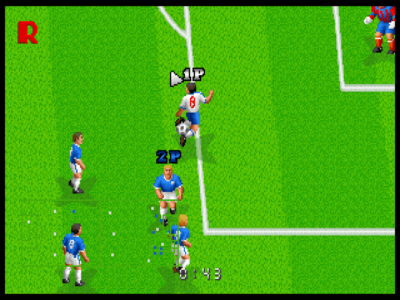
Players think nothing of flicking the ball over their own head. Like you tried to do at school and it didn’t work.
I always harboured suspicions that the two games shared some DNA, although in truth Action Soccer didn’t make much of an impression at the time. I blame the isometric perspective, which invited comparisons with the first FIFA game, and though it was quicker and more responsive than EA’s more famous effort, it nevertheless suffered from some of the same drawbacks, most notably the fact that an isometric view is a pretty crap one for football games. I also wasn’t a fan of the cartoony presentation, particularly the lack of real teams, with the choice instead being between a variety of largely animal-based sides.
Yes, you read that correctly: I said ‘animal-based’. Revisiting the game now, the strangeness of the presentation is one of its most striking features. If you ever wanted to control a side called The Fecund Beetles, you’re in luck (I actually had to double-check that fecund meant what I thought it meant) and though I’m not against creative solutions to a lack of official licensing, this is certainly a bit out there. There’s a zaniness that permeates the menu screens too, and at half time you’re presented with the image of a goalkeeper reclining in a hammock while eating a baguette.
Aside from their strange names, one other standout feature is that all the teams are evenly matched, in that they all have the same number of overall skill points, but they’re allocated differently. So some will be good at tackling, others at shooting, etc. But there’s no chance of picking the equivalent of Brazil and taking on the Faroe Islands just to ease yourself in. Eager to hedge my bets, I chose the average-at-everything team, The Ubi Cats (are cats known for all-round football skills?) and the easy difficulty setting, and headed onto the pitch.
As a seasoned veteran of ancient football games, with experience of a wide variety of difficulty levels, one comes to accept a certain learning curve, and perhaps to anticipate (and even welcome) some heavy defeats at the start. However, at no point did I expect my all-time record humiliation (previous worst: 7-0 during a particularly annoying session of Actua Soccer) to come at the hands of a close relative of my beloved Puma. 10-0! To a team of bloody turtles or whatever they were.
After some juggling of teams, formations and opponents bore no fruit, in desperation I switched from the isometric to the side-on view. At which point, the parallels with Puma became much more apparent. It’s strange – it’s very clearly the same game as in the isometric view, but while you’d have to be fairly eagle-eyed to spot the link between Action Soccer and Puma at that point, it’s very obvious once you make the change. I don’t know whether the old Puma skills kicked in, or whether the game just is easier, but it certainly became a more manageable proposition after the switch.
Many of the animations – running with the ball, the strange and unprompted skill animations, chest control, overhead kicks and cat-like goalkeepers – are reminiscent of Puma. On the CD version, there’s also the same, slightly strange commentary which only kicks in when play stops, invoking memories of my old CD-ROM drive whirring up to allow Martin Tyler to exclaim that the linesman has raised his *whirr* flag. There’s a different double act in the commentary box for this one though: Jonathan Pearce, who would probably rank top of a list of the most easily excitable English commentators, and some bloke with a North East accent (the John to Pearce’s Martin). The aim is at a more light-hearted tone, which is not desperately successful, and you soon learn to tune them both out. Although it’s impossible to ignore some of Pearce’s more ludicrous utterances: “Fast! Fluent! Football! Festival!”
The control scheme relies on two buttons instead of Puma’s three – one is a general kick/shoot, the other a guided pass. Passing is a bit weird as you have no control over the direction: an arrow indicates the general path the ball will take, which could either be a five-yard or fifty-yard effort. A glance at the pitch scanner will give you a reasonable guess, but it can easily get frustrating when you want to play a different ball to the one indicated by the arrow. Pressing kick will hoof it a bit, if all else fails, but in general you don’t have much freedom to move the ball about. Off the ball, you can attempt to regain possession via either a slide tackle or a shoulder charge. The referees are rather lenient, although they appear more concerned with punishing the more traditional method of tackling than the more violent-looking barges.
It’s an arcade-style effort, reminiscent of early International Superstar Soccer games or Super Sidekicks on the Neo Geo. Regardless of formation or strategy, players clump together at either end of the pitch, allowing players in midfield plenty of opportunity to run with the ball. Dribbling and strategic use of the pass button to loft the ball to waiting forwards is a viable approach, although as with Puma the goalkeepers are springy and athletic, able to repel chance after chance. There are a couple of reliable goalscoring methods, though, and putting the ball away does yield a sufficient amount of satisfaction.
The problem with such an overtly arcadey outlook is that, as you crank up the difficulty, the charming comedy elements morph into a general sense of unfairness that the odds are stacked against you. Defending goes from being slightly fraught to almost impossible, as you can neither get good distance on a clearance or rely on passing the ball out from the back. With the ball in the air, attackers can perform extravagant volleys, but there’s no defensive equivalent, and your players will simply attempt a tackle or shoulder charge rather than something useful like, say, a clearing header or volley. Tactics and formation tweaks don’t necessarily help, and even with plenty of defensive numbers you can find opponents camped in your box, laying siege to your goal with little chance of respite.
I’m not sure that I ever really recognised the differences between the teams in terms of ability, other than the odd moment when a player had a ball hit him in the face, which I took to be an indication of poor heading stats. It did seem at times that individual players had a bit more pace or more reliable shooting skills, but given that no information for players is provided, it could be my imagination. There is an editor, which allows you to alter the name of your team to something ridiculous (I’m 36 years old) or fiddle the attributes around a bit, but you can’t change kits or logos, or do anything else really. Tournament options, in single-player at least, are limited to one cup and one league competition, with no opportunity for customisation.
Action Soccer arguably makes more thematic sense than Puma, which always was a slightly puzzling combination of fast, end-to-end, shot-filled gameplay and comparatively serious presentation. Still, the latter is the better game. Much as it may baffle non-sports fans, you do need real teams, named players, proper competitions and tournaments – that’s not window dressing, it’s part of sport itself. Action Soccer is certainly playable for a while: a single league season is palatable enough, and it’s definitely aged better than the original FIFA International Soccer. But I can’t see many cranking up the difficulty and trying to guide their cat or dolphin-based team to the Ubi Cup Final. Possibly one for World Football fans only.

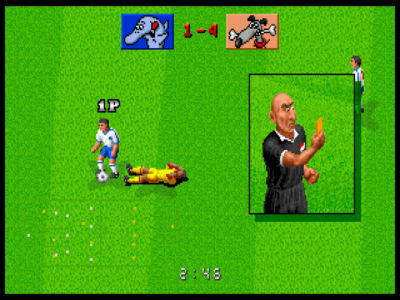
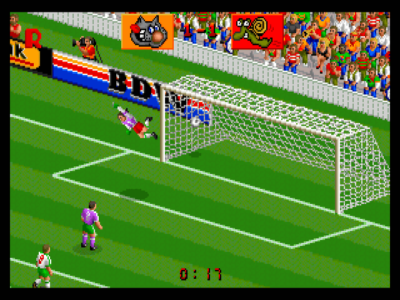
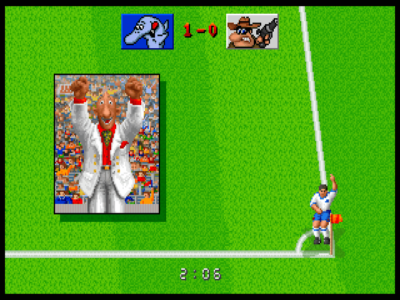
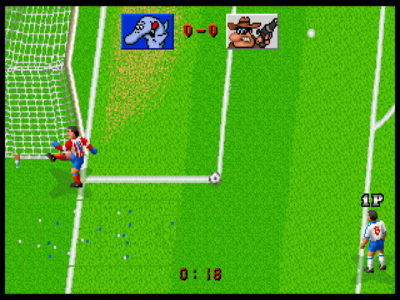

 Posts
Posts
I played this one quite a bit in the 90s, so I must have enjoyed it. Not anymore since then, though. Wasn’t there a setting to change “realism” between “arcade” and “simulation”? I wonder what that did.
December 24, 2017 @ 2:57 pm
I had another look in case I missed it, but I didn’t see any arcade/simulation setting in this one. Although that was a staple feature of footy games at one point, even if it was always difficult to tell what difference it made.
The switch of viewpoint did seem quite significant, beyond a simple change of camera angle. And now that you mention it, I do have vague memories of the manual saying that one view provided a more ‘realistic’ experience…
December 25, 2017 @ 10:09 am
Hm, maybe I’m getting my football games mixed up. Should check some day.
December 25, 2017 @ 11:55 am